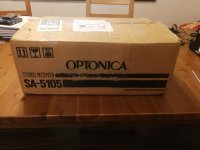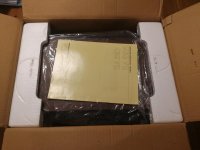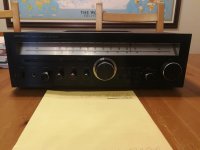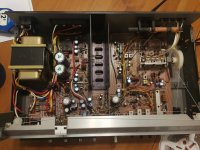Hi all,
As a young man I owned an Optonica SA-5605 in the 80s and early 90s. It was my pride and joy until I was forced to sell it to make rent.
Recently a wave of nostalgia took hold of me, and I purchased an Optonica SA-5105 receiver from a charity thrift store on eBay. It was described as having been part of a large corporate donation of new-in-box and floor model electronics. I won the auction and stole the thing for $64.
Of course, you never know what you're going to get from eBay until you get it, but when it arrived it was, indeed, in its original box, in plastic, with all the paperwork, user manual, etc. Exterior is in perfect condition. I opened it up and it was super clean inside, just a very very light bit of dust. The only indication that it had been used at all was the tuning pointer light was burned out. I replaced it and it works perfectly. There was a little noise on the volume knob, so I gave all the pots a deoxit-ing. All is quiet, and the receiver seems to work very well. It sounds great running though a pair of vintage Minimus 7s with upgraded crossovers.
My question is this: is there anything in the electronics themselves that I should be worried about in such an old - but essentially brand new - receiver?
As a young man I owned an Optonica SA-5605 in the 80s and early 90s. It was my pride and joy until I was forced to sell it to make rent.
Recently a wave of nostalgia took hold of me, and I purchased an Optonica SA-5105 receiver from a charity thrift store on eBay. It was described as having been part of a large corporate donation of new-in-box and floor model electronics. I won the auction and stole the thing for $64.
Of course, you never know what you're going to get from eBay until you get it, but when it arrived it was, indeed, in its original box, in plastic, with all the paperwork, user manual, etc. Exterior is in perfect condition. I opened it up and it was super clean inside, just a very very light bit of dust. The only indication that it had been used at all was the tuning pointer light was burned out. I replaced it and it works perfectly. There was a little noise on the volume knob, so I gave all the pots a deoxit-ing. All is quiet, and the receiver seems to work very well. It sounds great running though a pair of vintage Minimus 7s with upgraded crossovers.
My question is this: is there anything in the electronics themselves that I should be worried about in such an old - but essentially brand new - receiver?
Attachments
My gut feeling says: If it works - don't fix it.
🙂
Indeed, a superb piece of equipment, from the looks.
🙂
Indeed, a superb piece of equipment, from the looks.
If the amplifier hadn't been used much over the years since the the 1980s, I wouldn't expect to see physical signs of the caps deteriorating. However, there appear to be replacements here already (those with the pressure relief cuts in the top, for example) and the remaining old ones could well be on the way to elcap heaven too.
Unless you have an ESR meter to test them properly, I'd make a list of those caps and put it with your list of projects to do before problems arise. It would seem logical to me that if some caps have already failed and needed replacement, others will follow.
Unless you have an ESR meter to test them properly, I'd make a list of those caps and put it with your list of projects to do before problems arise. It would seem logical to me that if some caps have already failed and needed replacement, others will follow.
Fair statement - about those two main caps in the power supply section.
Those are the ones that traditionally get most of a beating from rectification spikes and ripple currents. Power supply specific.
But all the rest of the smaller ones - most probably operate in much more relaxed conditions, so just maybe they are not in such a bad shape quite yet after all?
Those are the ones that traditionally get most of a beating from rectification spikes and ripple currents. Power supply specific.
But all the rest of the smaller ones - most probably operate in much more relaxed conditions, so just maybe they are not in such a bad shape quite yet after all?
I guess it depends on where capacitors are placed in circuit but broadly speaking, how does changed ESR affect performance(frequency response ? Distortion ?) of an amplifier ? Any critical area that needs more attention ?
Thanks and regards.
Thanks and regards.
Try playing around with this very nice PSU Design Simulator V.2.0.I guess it depends on where capacitors are placed in circuit but broadly speaking, how does changed ESR affect performance(frequency response ? Distortion ?) of an amplifier ? Any critical area that needs more attention ?
Thanks and regards.
Basically, the way I understand it, ageing electrolytic capacitors tend to increase their value of ESR. When you put higher ESR values into this simulator, you will most probably observe that the ripple content on the output of such PSU will gradually increase a bit. But then, the ringing / overshoot on such capacitors with higher ESR will be somewhat lower.
PSUD2
As for amplifier performance / distortion - I would suppose that it all depends on which specific cap you have in mind.
For example, the shunt / decoupling cap to ground, as in the negative feedback loop, would probably be an interesting case to analyse.
Some amplifiers have a bipolar electrolytic capacitor directly at their low signal inputs. Such bipolars, playing the role of DC decoupling and/or input filter circuit, should probably also be a case of diligent care and analysis.
I would guess.
I think that if you are going to treat an old product as a new purchase and depend on it as your go-to amp, it's far better to start afresh without nagging doubts and maybes about old caps - particularly if you're the OP and expect to hear the sound quality you enjoyed long ago. Old Caps may "work" OK and their capacitance readings may even be within tolerance but when you hear a full recap or where appropriate ESR testing has been done, you come to appreciate the dramatic difference when the job is done thoroughly, as a professional repairer would with top shelf gear.......But all the rest of the smaller ones - most probably operate in much more relaxed conditions, so just maybe they are not in such a bad shape quite yet after all?
Equivalent Series Resistance is about the easiest to measure parameter of electrolytic caps which relates to their age condition. That's why most techs use the meters or wouldn't be without one as a backup, because it means saving time and money for their business and their reputation, by removing doubt.
Since this is a receiver, many of those small caps are actually in the preamp and tuner sections. I would hesitate to jump in and replace caps in a tuner without looking at the schematic to see if they may affect tuned circuits. You don't want to play with these on an FM tuner of this vintage because finding a tech to then fix your handiwork may be kinda difficult and your jaw may drop at the cost. You needn't expect problems with the preamp but take care that signal coupling caps may be non-polarized types there. These are replaceable but are a little harder to find than conventional types.
Thanks for the responses. Please forgive a couple of probably very basic questions.
1) What is it about the appearance of the main power supply caps that indicates that they are replacements? Do the cuts indicate a newer cap than the age of the receiver? Did they not look like that in 1979?
2) RE: the cautions against changing caps in the tuning section - I pretty much have no intentions of using the tuner unless maybe there's a storm and I want to listen to the weather. 99% of what I listen to will come in through the AUX jacks. In that case, could I simply check and recap the amp and preamp areas?
Thanks again for the guidance and info. Much appreciated.
1) What is it about the appearance of the main power supply caps that indicates that they are replacements? Do the cuts indicate a newer cap than the age of the receiver? Did they not look like that in 1979?
2) RE: the cautions against changing caps in the tuning section - I pretty much have no intentions of using the tuner unless maybe there's a storm and I want to listen to the weather. 99% of what I listen to will come in through the AUX jacks. In that case, could I simply check and recap the amp and preamp areas?
Thanks again for the guidance and info. Much appreciated.
Yes , you can virtually ignore the tuner if you wish. Typically, these remain unpowered until selected by the appropriate selector switch so there should be no problem with leaving it "as is" if you don't plan to use the tuner. The dial lamps may remain on if they are OK but I imagine the tuner itself will not be functional in that state.
The image may lie, but the large caps and apparently most of those in the power amplifier are of a more recent style with the "cut" type tops. You don't see this type elsewhere in the preamp/tone control section or tuner, just the power amplifier, located between the transformer and the heatsink. The old, grey and light blue sleeved cap. types with flat tops are typical of the 1970s-80s period, either with no safety relief or in the form of a rubber seal in the base of large caps.
I like to think that this is how a pro. would service a power amp to ensure the customer would be happy with the sound now and in the future - a full recap in the areas that get hot and caps deteriorate sooner.
The image may lie, but the large caps and apparently most of those in the power amplifier are of a more recent style with the "cut" type tops. You don't see this type elsewhere in the preamp/tone control section or tuner, just the power amplifier, located between the transformer and the heatsink. The old, grey and light blue sleeved cap. types with flat tops are typical of the 1970s-80s period, either with no safety relief or in the form of a rubber seal in the base of large caps.
I like to think that this is how a pro. would service a power amp to ensure the customer would be happy with the sound now and in the future - a full recap in the areas that get hot and caps deteriorate sooner.
Member
Joined 2009
Paid Member
very nice find! it will be a shame not to hear it first without making any changes and you may find that no changes are required - it will be so nice to keep it fully original
you could get hold of a Variac and power up gently at first - this allows the capacitors to re-form gently if required
Once you’re satisfied that there’s no smoke maybe leave it turn on for a while to give it a bit of a soak test
you could get hold of a Variac and power up gently at first - this allows the capacitors to re-form gently if required
Once you’re satisfied that there’s no smoke maybe leave it turn on for a while to give it a bit of a soak test
- Status
- Not open for further replies.
- Home
- Amplifiers
- Solid State
- 40 year-old new old stock Optonica receiver - Anything I should worry about?



